Platinum Group Minerals Associated with Nickel-Bearing Sulfides from the Jatobá Iron Oxide-Copper-Gold Deposit, Carajás Domain, Brazil
Abstract
:1. Introduction
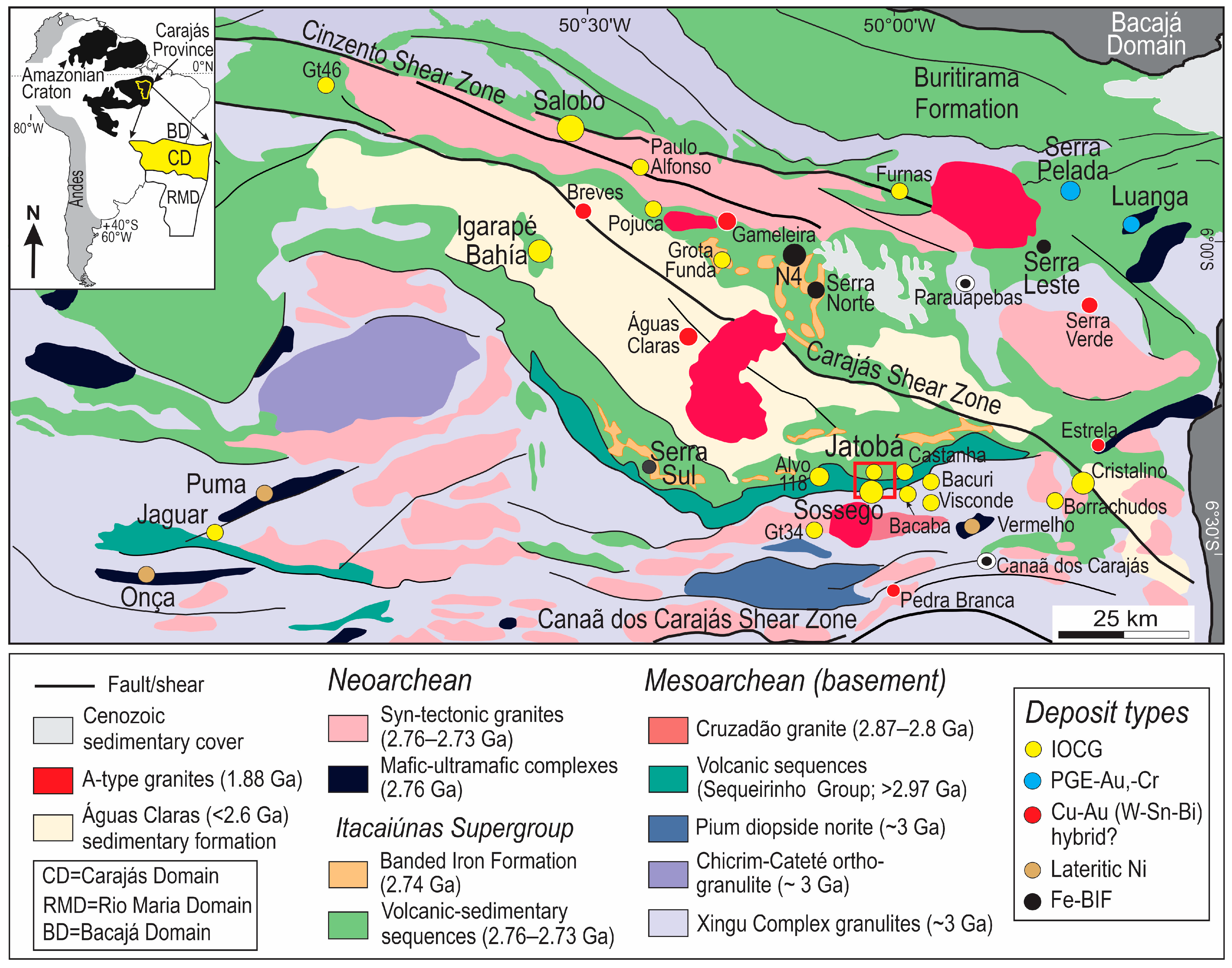
2. Background
2.1. Geology and Geological Evolution of the Carajás Domain
2.2. IOCG Deposits of the Carajás Domain
2.3. Nickel and Platinum Group Element Endowment in the Carajás Domain
2.4. The Jatobá Deposit
3. Samples and Analytical Methodology
4. Results
4.1. Ore Petrography and Mineralogy
4.2. Accessory Ore Minerals
4.3. Platinum Group Minerals
4.4. Trace Element Concentrations in Sulfides
4.5. Grain-Scale Trace Element Distributions in Pyrite
5. Discussion
5.1. Origin, Trace Element Signatures, and Successive Generations of Jatobá Sulfides
5.2. PGM in Ni-Bearing Sulfides—Identifying the Potential Source
5.3. Which Ore Genesis Model Best Explains the Evidence?
6. Conclusions and Implications
Supplementary Materials
Author Contributions
Funding
Data Availability Statement
Acknowledgments
Conflicts of Interest
References
- Barton, M. Iron oxide (-Cu-Au-REE-P-Ag-U-Co) systems. In Treatise on Geochemistry, 2nd ed.; Elsevier: Amsterdam, The Netherlands, 2014; Volume 13, pp. 515–541. [Google Scholar]
- Skirrow, R.G. Iron oxide copper-gold (IOCG) deposits-a review (part 1): Settings, mineralogy, ore geochemistry and classification. Ore Geol. Rev. 2022, 140, 104569. [Google Scholar] [CrossRef]
- Hitzman, M.W.; Oreskes, N.; Einaudi, M.T. Geological characteristics and tectonic setting of Proterozoic iron oxide (Cu-U-Au-REE) deposits. Precambr. Res. 2002, 58, 241–287. [Google Scholar] [CrossRef]
- Bidgood, A.; Hitzman, M. New models to aid the discovery of critical raw material deposits for the Green Stone Age. In The Green Stone Age: Exploration and Exploitation of Minerals for Green Technologies; Smelror, M., Hanghøj, K., Schiellerup, H., Eds.; Geological Society, London, Special Publications: London, UK, 2022; Volume 526, pp. 183–191. [Google Scholar] [CrossRef]
- Grainger, C.J.; Groves, D.I.; Tallarico, F.H.B.; Fletcher, I.R. Metallogenesis of the Carajás mineral province, southern Amazon Craton, Brazil: Varying styles of Archean through Paleoproterozoic to Neoproterozoic base- and precious-metal mineralisation. Ore Geol. Rev. 2008, 33, 451–489. [Google Scholar] [CrossRef]
- Monteiro, L.V.S.; Xavier, R.P.; de Souza Filho, C.R.; Moreto, C. Metalogênese da Província Carajás. In Metalogênese das Províncias Tectônicas Brasileiras; da Glória da Silva, M., da Costa Neto, M.B., Jost, H., Kuyumjian, R.M., Eds.; CPRM Serviço Geológico do Brasil: Belo Horizonte, Brazil, 2014; pp. 43–92. [Google Scholar]
- Tavares, F.M.; Trouw, R.A.J.; Silva, C.M.G.; Justo, A.P.; Oliveira, J.K.M. The multistage tectonic evolution of the northeastern Carajás Province, Amazonian Craton, Brazil: Revealing complex structural patterns. J. S. Am. Earth Sci. 2018, 88, 238–252. [Google Scholar] [CrossRef]
- Schutesky, M.E.; de Oliveira, C.G. From the roots to the roof: An integrated model for the Neoarchean Carajás IOCG System, Brazil. Ore Geol. Rev. 2020, 127, 103833. [Google Scholar] [CrossRef]
- Trunfull, E.F.; Hagemann, S.G.; Xavier, R.P.; Moreto, C.P.N. Critical assessment of geochronological data from the Carajás Mineral Province, Brazil: Implications for metallogeny and tectonic evolution. Ore Geol. Rev. 2020, 121, 103556. [Google Scholar] [CrossRef]
- Toledo, P.I.F.; Moreto, C.P.N.; Monteiro, L.V.S.; Melo, G.H.C.; Matos, F.M.V.; Xavier, R.P.; Carvalho, J.A.; Filho, C.A.M.; Navarro, M.S.; Lana, C.C. Breaking up the temporal link between granitic magmatism and iron oxide-copper-gold (IOCG) deposits in the Carajás Mineral Province, NW Brazil. Miner. Depos. 2024, 59, 601–625. [Google Scholar] [CrossRef]
- Xavier, R.P.; Soares Monteiro, L.V.; Moreto, C.P.N.; Pestilho, A.L.S.; Coelho de Melo, G.H.; Delinardo da Silva, M.A.; Aires, B.; Ribeiro, C.; Freitas e Silva, F.H. The Iron Oxide Copper-Gold Systems of the Carajás Mineral Province, Brazil. In Geology and Genesis of Major Copper Deposits and Districts of the World: A Tribute to Richard H. Sillitoe; Hedenquist, J.W., Harris, M., Camus, F., Eds.; Society of Economic Geologists: Littleton, CO, USA, 2012; Volume 16, 22p. [Google Scholar]
- Monteiro, L.V.S.; Xavier, R.P.; Carvalho, E.R.; Hitzman, M.W.; Johnson, C.A.; Souza, C.R.; Filho, C.R.; Torresi, I. Spatial and temporal zoning of hydrothermal alteration and mineralization in the Sossego iron oxide-copper-gold deposit Carajás Mineral Province, Brazil: Paragenesis and stable isotope constraints. Miner. Depos. 2008, 43, 129–159. [Google Scholar] [CrossRef]
- Monteiro, L.V.; Xavier, R.P.; Hitzman, M.W.; Juliani, C.; de Souza Filho, C.R.; Carvalho, E.D. Mineral chemistry of ore and hydrothermal alteration at the Sossego iron oxide-copper-gold deposit, Carajás Mineral Province, Brazil. Ore Geol. Rev. 2008, 34, 317–336. [Google Scholar] [CrossRef]
- Moreto, C.P.N.; Monteiro, L.V.S.; Xavier, R.P.; Creaser, R.A.; Dufrane, S.A.; Tassinari, C.C.G.; Sato, K.; Kemp, A.I.S.; Amaral, W.S. Neoarchean and Paleoproterozoic iron oxide-copper-gold events at the Sossego deposit, Carajás Province, Brazil, Re-Os and U-Pb geochronological evidence. Econ. Geol. 2015, 110, 809–835. [Google Scholar] [CrossRef]
- Tassinari, C.C.G.; Mellito, M.K.; Babinski, M. Age and origin of the Cu (Au-Mo-Ag) Salobo 3A ore deposit, Carajás Mineral Province, Amazonian Craton, northern Brazil. Episodes 2003, 26, 2–9. [Google Scholar] [CrossRef]
- Melo, G.H.C.; Monteiro, L.V.S.; Xavier, R.P.; Moreto, C.P.N.; Santiago, E.S.B.; Dufrane, S.A.; Aires, B.; Santos, A.F.F. Temporal evolution of the giant Salobo IOCG deposit, Carajás Province (Brazil): Constraints from paragenesis of hydrothermal alteration and U-Pb geochronology. Miner. Depos. 2017, 52, 709–732. [Google Scholar] [CrossRef]
- Campo-Rodríguez, Y.T.; Schutesky, M.E.; de Oliveira, C.G.; Whitehouse, M.J. Unveiling the polyphasic evolution of the Neoarchean IOCG Salobo deposit, Carajás Mineral Province, Brazil: Insights from magnetite trace elements and sulfur isotopes. Ore Geol. Rev. 2021, 140, 104572. [Google Scholar] [CrossRef]
- Tallarico, F.H.B.; Figueiredo, B.R.; Groves, D.I.; Kositcin, N.; McNaughton, N.J.; Fletcher, I.R.; Rego, J.L. Geology and SHRIMP U-Pb geochronology of the Igarape Bahia Deposit, Carajás copper-gold belt, Brazil, an Archean (2.57 Ga) example of iron-oxide Cu-Au-(U-REE) mineralization. Econ. Geol. 2005, 100, 7–28. [Google Scholar] [CrossRef]
- de Melo, G.H.C.; Monteiro, L.V.S.; Xavier, R.P.; Moreto, C.P.N.; Santiago, E. Tracing Fluid Sources for the Salobo and Igarape Bahia Deposits: Implications for the Genesis of the Iron Oxide Copper-Gold Deposits in the Carajás Province, Brazil. Econ. Geol. 2019, 114, 697–718. [Google Scholar] [CrossRef]
- Veloso, A.S.R.; Monteiro, L.V.S.; Juliani, C. The link between hydrothermal nickel mineralization and an iron oxide-copper-gold (IOCG) system: Constraints based on mineral chemistry in the Jatobá deposit, Carajás Province. Ore Geol. Rev. 2020, 121, 103555. [Google Scholar] [CrossRef]
- González-Álvarez, I.; Pirajno, F.; Kerrich, R. Hydrothermal nickel deposits: Secular variation and diversity. Ore Geol. Rev. 2013, 52, 1–3. [Google Scholar] [CrossRef]
- Oliveira, M.M.F. Caracterização e Metalogênese do Depósito de Ni do Jaguar, Província Mineral de Carajás. Master’s Thesis, Universidade de Brasília, Brasília, Brazil, 2017; 115p. [Google Scholar]
- Ferreira Filho, C.F.; Ferraz de Oliveira, M.M.; Mansur, E.T.; Rosa, W.D. The Jaguar hydrothermal nickel sulfide deposit: Evidence for a nickel-rich member of IOCG-type deposits in the Carajás Mineral Province, Brazil. J. S. Am. Earth Sci. 2021, 111, 103501. [Google Scholar] [CrossRef]
- Mansur, E.T.; Dare, S.A.S.; Ferreira Filho, C.F.; Rodrigues Miranda, A.C.; Soares Monteiro, L.V. The distribution of trace elements in sulfides and magnetite from the Jaguar hydrothermal nickel deposit: Exploring the link with IOA and IOCG deposits within the Carajás Mineral Province, Brazil. Ore Geol. Rev. 2023, 152, 105256. [Google Scholar] [CrossRef]
- Garcia, V.B.; Schutesky, M.E.; Oliveira, C.G.; Whitehouse, M.J.; Huhn, S.R.B.; Augustin, C.T. The Neoarchean GT-34 Ni deposit, Carajás mineral Province, Brazil: An atypical IOCG-related Ni sulfide mineralization. Ore Geol. Rev. 2020, 127, 103773. [Google Scholar] [CrossRef]
- Craveiro, G.S.; Xavier, R.P.; Villas, R.N.N. The Cristalino IOCG deposit: An example of multi-stage events of hydrothermal alteration and copper mineralization. Braz. J. Geol. 2019, 49, e20180015. [Google Scholar] [CrossRef]
- Pestilho, A.L.S.; Monteiro, L.V.S.; de Melo, G.H.C.; Moreto, C.P.N.; Juliani, C.; Fallick, A.E.; Xavier, R.P. Stable isotopes and fluid inclusion constraints on the fluid evolution in the Bacaba and Castanha iron oxide-copper-gold deposits, Carajás Mineral Province, Brazil. Ore Geol. Rev. 2020, 126, 103738. [Google Scholar] [CrossRef]
- Siepierski, L.; Ferreira Filho, C.F. Spinifex-textured komatiites in the south border of the Carajás ridge, Selva Greenstone belt, Carajás Province, Brazil. J. S. Am. Earth Sci. 2016, 66, 41–55. [Google Scholar] [CrossRef]
- Dutra, L.F.; Louro, V.H.A.; Monteiro, L.V.S. The southern IOCG and hydrothermal nickel mineralization trend of the Carajás Mineral Province: Airborne geophysical and remote sensing evidences for structural controls and hydrothermal signature. J. Appl. Geophys. 2023, 213, 105016. [Google Scholar] [CrossRef]
- Vasquez, L.V.; Rosa-Costa, L.R.; Silva, C.G.; Ricci, P.F.; Barbosa, J.O.; Klein, E.L.; Lopes, E.S.; Macambira, E.B.; Chaves, C.L.; Carvalho, J.M.; et al. Geologia e Recursos Minerais do Estado do Pará: Sistema de Informações Geográficas-SIG: Texto explicativo dos mapas Geológico e Tectônico e de Recursos Minerais do Estado do Pará 1:1.000.000; CPRM: Belém, Brazil, 2008; 328p. [Google Scholar]
- da Costa, F.G.; Araújo dos Santos, P.; de Oliveira Serafim, I.C.C.; Costa, I.S.L.; Roopnarain, S. From Mesoarchean drips to modern-style tectonics in the Carajás Province, Amazonian Craton. J. S. Am. Earth Sci. 2020, 104, 102817. [Google Scholar] [CrossRef]
- Araújo, O.D.; Maia, R.G.N.; João, X.J.; Costa, J.B.S. A megaestruturação arqueana da folha Serra dos Carajás. In Congresso Latino-Americano de Geologia; SBG: Belém, Brazil, 1988; Volume 7, pp. 324–338. [Google Scholar]
- Machado, N.; Lindenmayer, Z.; Krogh, T.E.; Lindenmayer, D. U-Pb geochronology of Archean magmatism and basement reactivation in the Carajás area, Amazon shield, Brazil. Precambr. Res. 1991, 49, 329–354. [Google Scholar] [CrossRef]
- Martins, P.L.G.; Toledo, C.L.B.; Silva, A.M.; Chemale, F., Jr.; Santos, J.O.S.; Assis, L.M. Neoarchean magmatism in the southeastern Amazonian Craton, Brazil: Petrography, geochemistry and tectonic significance of basalts from the Carajás Basin. Precambr. Res. 2017, 302, 340–357. [Google Scholar] [CrossRef]
- DOCEGEO. Revisão litoestratigráfica da província mineral de Carajás. In Litoestratigrafia e Principais Depósitos Minerais, Proceedings of the Anexo do 35. Congresso Brasileiro de Geologia, Belém, Brazil, 1988; SBG, Anexo aos anais: Belém, Brazil, 1988; Volume 35, pp. 11–54. [Google Scholar]
- Feio, G.R.L.; Dall’Agnol, R.; Dantas, E.L.; Macambira, M.J.B.; Santos, J.O.S.; Althoff, F.J.; Soares, J.E.B. Archean granitoid magmatism in the Canaã dos Carajás area: Implications for crustal evolution of the Carajás province, Amazonian Craton, Brazil. Precambr. Res. 2013, 227, 157–185. [Google Scholar] [CrossRef]
- Moreto, C.P.N.; Monteiro, L.V.S.; Xavier, R.P.; Creaser, R.A.; Dufrane, S.A.; Melo, G.H.C.; Silva, M.A.D.; Tassinari, C.C.G.; Sato, K. Timing of multiple hydrothermal events in the iron oxide-copper gold deposits of the Southern Copper Belt, Carajás Province, Brazil. Miner. Depos. 2015, 50, 517–546. [Google Scholar] [CrossRef]
- Teixeira, M.F.B.; Dall’Agnol, R.; Santos, J.O.S.; de Oliveira, D.C.; Lamarão, C.N.; McNaughton, N.J. Crystallization ages of Paleoproterozoic A-type granites of Carajás province, Amazon craton: Constraints from U-Pb geochronology of zircon and titanite. J. S. Am. Earth Sci. 2018, 88, 312–331. [Google Scholar] [CrossRef]
- Teixeira, W.; Hamilton, M.A.; Girardi, V.A.V.; Faleiros, F.M. U-Pb baddeleyite ages of key dyke swarms in the Amazonian Craton (Carajás/Rio Maria and Rio Apa areas): Tectonic implications for events at 1880, 1110 Ma, 535 Ma and 200 Ma. Precambr. Res. 2019, 329, 138–155. [Google Scholar] [CrossRef]
- Araújo Filho, R.C.; Nogueira, A.C.R.; Araújo, R.N. New stratigraphic proposal of a Paleoproterozoic siliciclastic succession: Implications for the evolution of the Carajás Basin, Amazonian Craton, Brazil. J. S. Am. Earth Sci. 2020, 102, 102665. [Google Scholar] [CrossRef]
- de Melo, G.H.C.; Monteiro, L.V.S.; Hunger, R.B.; Toledo, P.I.F.; Xavier, R.P.; Zhao, X.F.; Su, Z.K.; Moreto, C.P.N.; Pereira de Jesus, S.d.S.G. Magmatic-hydrothermal fluids leaching older seafloor exhalative rocks to form the IOCG deposits of the Carajás Province, Brazil: Evidence from boron isotopes. Precambr. Res. 2021, 365, 106412. [Google Scholar] [CrossRef]
- Almeida, F.F.M.; Hasui, Y.; Brito Neves, B.B.; Fuck, R.A. Brazilian structural provinces: An introduction. Earth Sci. Rev. 1981, 17, 1–29. [Google Scholar] [CrossRef]
- Xavier, R.P.; Moreto, C.; de Melo, G.H.C.; Toledo, P.; Hunger, R.; Delinardo, M.; Faustinoni, J.; Lopes, A.; Monteiro, L.V.S.; Previato, M.; et al. Geology and Metallogeny of Neoarchean and Paleoproterozoic Copper Systems of the Carajás Domain, Amazonian Craton, Brazil. In Proceedings of the Mineral Resources to Discover-14th SGA Biennial Meeting, Quebec, QC, Canada, 20–23 August 2017; pp. 899–902. [Google Scholar]
- Teixeira, A.S.; Ferreira Filho, C.F.; Della Giustina Schutesky, M.E.; Araújo, S.M.; da Silva, H.H.A.B. Geology, petrology and geochronology of the Lago Grande layered complex: Evidence for a PGE-mineralized magmatic suite in the Carajás Mineral Province, Brazil. J. S. Am. Earth Sci. 2015, 64, 116–138. [Google Scholar] [CrossRef]
- Diella, V.; Ferrario, A.; Girardi, V.A.V. PGE and PGM in the Luanga mafic-ultramafic intrusion in Serra dos Carajás (Pará State, Brazil). Ore Geol. Rev. 1995, 9, 445–453. [Google Scholar] [CrossRef]
- Mansur, E.T.; Ferreira Filho, C.F. Magmatic structure and geochemistry of the Luanga Mafic-Ultramafic Complex: Further constraints for the PGE-mineralized magmatism in Carajás, Brazil. Lithos 2016, 266–267, 28–43. [Google Scholar] [CrossRef]
- Mansur, E.T.; Ferreira Filho, C.F.; Oliveira, D.P.L. The Luanga deposit, Carajás Mineral Province, Brazil: Different styles of PGE mineralization hosted in a medium-size layered intrusion. Ore Geol. Rev. 2020, 118, 103340. [Google Scholar] [CrossRef]
- Moroni, M.; Girardi, V.A.; Ferrario, A. The Serra Pelada Au-PGE deposit, Serra dos Carajás (Pará State, Brazil): Geological and geochemical indications for a composite mineralising process. Miner. Depos. 2001, 36, 768–785. [Google Scholar] [CrossRef]
- Cabral, A.R.; Lehmann, B.; Kwitko, R.; Costa, C.H.C. The Serra Pelada Au-Pd-Pt deposit, Carajás mineral province, northern Brazil: Reconnaissance mineralogy and chemistry of very high grade palladian gold mineralization. Econ. Geol. 2002, 97, 1127–1138. [Google Scholar] [CrossRef]
- Cabral, A.R.; Lehmann, B.; Burgess, R. Late Cretaceous bonanza-style metal enrichment in the Serra Pelada Au-Pd-Pt deposit Pará Brazil. Econ. Geol. 2011, 106, 119–125. [Google Scholar] [CrossRef]
- Pollard, P.J.; Taylor, R.G.; Peters, L.; Matos, F.; Freitas, C.; Saboia, L.; Huhn, S. 40Ar-39Ar dating of Archean iron oxide Cu-Au and Paleoproterozoic granite-related Cu-Au deposits in the Carajás Mineral Province, Brazil: Implications for genetic models. Miner. Depos. 2018, 54, 329–346. [Google Scholar] [CrossRef]
- Lancaster, J.O.; Fanton, J.; Almeida, A.J.; Leveille, R.A.; Vieira, S. Discovery and geology of the Sossego copper-gold deposit, Carajás District, Pará State, Brazil. In Proceedings of the 31st International Geological Congress, Rio de Janeiro, Brazil, 6–17 August 2000. [Google Scholar]
- Veloso, A.S.R. Evolução Metalogenetica do Deposito de Cu-(Zn) Jatobá, Provincia Mineral de Carajás. Ph.D. Thesis, University of São Paolo, São Paulo, Brazil, 2017; 197p. [Google Scholar]
- Campo-Rodriguez, Y.T.; Ciobanu, C.L.; Slattery, A.; Cook, N.J.; Schutesky, M.E.; Ehrig, K.; King, S.A.; Yao, J. Polysomatic intergrowths between amphiboles and non-classical pyriboles in magnetite: Smallest-scale features recording a protracted geological history. Am. Mineral. 2024, in press. [CrossRef]
- Belousov, I.; Danyushevsky, L.; Goemann, K.; Gilbert, S.; Olin, P.; Thompson, J.; Lounejeva, E.; Garbe-Schönberg, D. STDGL3, a reference material for analysis of sulfide minerals by Laser Ablation ICP-MS: An assessment of matrix effects and the impact of laser wavelengths and pulse widths. Geostand. Geoanal. Res. 2023, 47, 493–508. [Google Scholar] [CrossRef]
- Gilbert, S.; Danyushevsky, L.; Robinson, P.; Wohlgemuth-Ueberwasser, C.; Pearson, N.; Savard, D.; Norman, M.; Hanley, J. A comparative study of five reference materials and the Lombard meteorite for the determination of the platinum-group elements and gold by LA-ICP-MS. Geostand. Geoanalytical Res. 2013, 37, 51–64. [Google Scholar] [CrossRef]
- Paton, C.; Hellstrom, J.; Paul, B.; Woodhead, J.; Hergt, J. Iolite: Freeware for the visualisation and processing of mass spectrometric data. J. Anal. At. Spectrom. 2011, 26, 2508–2518. [Google Scholar] [CrossRef]
- Santiago, E.S.B.; Xavier, R.P.; Hagemann, S.G.; Monteiro, L.V.S.; Cliff, J. Multiple sulfur isotopes constraints on origin and evolution of the Neoarchean and Paleoproterozoic Cu-Au systems from the Carajás Domain, Amazonian Craton, Brazil. Ore Geol. Rev. 2021, 129, 103872. [Google Scholar] [CrossRef]
- Pašava, J.; Vymazalová, A.; Petersen, S.; Herzig, P. PGE distribution in massive sulfides from the PACMANUS hydrothermal field, eastern Manus basin, Papua New Guinea: Implications for PGE enrichment in some ancient volcanogenic massive sulfide deposits. Miner. Depos. 2004, 39, 784–792. [Google Scholar] [CrossRef]
- Pašava, J.; Vymazalová, A.; Tornos, F. PGE distribution in massive sulfide deposits of the Iberian Pyrite Belt. Miner. Depos. 2007, 42, 309–314. [Google Scholar] [CrossRef]
- McFall, K.; McDonald, I.; Wilkinson, J.J. Chapter 15: Assessing the role of tectono-magmatic setting in the precious metal (Au, Ag, PGE) and critical metal (Te, Se, Bi) endowment of porphyry Cu deposits. In Tectonomagmatic Influences on Metallogeny and Hydrothermal Ore Deposits: A Tribute to Jeremy P. Richards (Volume II); Society of Economic Geologists: Littleton, CO, USA, 2021; Volume 2, pp. 277–295. [Google Scholar] [CrossRef]
- Park, J.-W.; Campbell, I. Platinum-group element geochemistry of the volcanic rocks associated with the Jaguar and Bentley Cu-Zn volcanogenic massive sulfide (VMS) deposits, Western Australia: Implications for the role of chalcophile element fertility on VMS mineralization. Miner. Depos. 2021, 56, 583–600. [Google Scholar] [CrossRef]
- Lowczak, J.N.; Campbell, I.H.; Cocker, H.; Park, J.W.; Cooke, D.R. Platinum-group element geochemistry of the Forest reef Volcanics, southeastern Australia: Implications for porphyry au-cu mineralisation. Geochim. Cosmochim. Acta 2018, 220, 385–406. [Google Scholar] [CrossRef]
- Crespo, J.; Reich, M.; Barra, F.; Verdugo, J.J.; Martínez, C. Critical Metal Particles in Copper Sulfides from the Supergiant Río Blanco Porphyry Cu-Mo Deposit, Chile. Minerals 2018, 8, 519. [Google Scholar] [CrossRef]
- Duran, C.J.; Barnes, S.J.; Pleše, P.; Prašek, M.K.; Zientek, M.L.; Pagé, P. Fractional crystallization-induced variations in sulfides from the Noril’sk-Talnakh mining district (polar Siberia, Russia). Ore Geol Rev. 2017, 90, 326–351. [Google Scholar] [CrossRef]
- Barnes, S.J.; Liu, W. Pt and Pd mobility in hydrothermal fluids: Evidence from komatiites and from thermodynamic modelling. Ore Geol. Rev. 2012, 44, 49–58. [Google Scholar] [CrossRef]
- Sullivan, N.A.; Zajacz, Z.; Brenan, J.M.; Tsay, A. The solubility of platinum in magmatic brines: Insights into the mobility of PGE in ore-forming environments. Geochim. Cosmochim. Acta 2022, 316, 253–272. [Google Scholar] [CrossRef]
- Sullivan, N.A.; Zajacz, Z.; Brenan, J.M.; Hinde, J.C.; Tsay, A.; Yin, Y. The solubility of gold and palladium in magmatic brines: Implications for PGE enrichment in mafic-ultramafic and porphyry environments. Geochim. Cosmochim. Acta 2022, 316, 230–252. [Google Scholar] [CrossRef]
- Mukwakwami, J.; Lafrance, B.; Lesher, C.M.; Tinkham, D.K.; Rayner, N.M.; Ames, D.E. Deformation, metamorphism, and mobilization of Ni-Cu-PGE sulfide ores at Garson Mine, Sudbury. Miner. Depos. 2014, 49, 175–198. [Google Scholar] [CrossRef]
- Wang, S.M.; Wu, C.Z.; Muhtar, M.N.; Lei, R.X.; Brzozowski, M.J. Mobilization of ore-forming metals during post-magmatic hydrothermal overprinting of the Huangshandong Ni-Cu sulfide deposit, Eastern Tianshan, NW China. Ore Geol. Rev. 2021, 137, 104315. [Google Scholar] [CrossRef]
- Almeida, C.M.; Olivo, G.R.; Carvalho, S.G. The Ni-Cu-PGE sulfide ores of the komatiite-hosted Fortaleza de Minas deposit, Brazil: Evidence of hydrothermal remobilization. Can. Mineral. 2007, 45, 751–773. [Google Scholar] [CrossRef]
- Keays, R.R.; Jowitt, S.M. The Avebury Ni deposit, Tasmania: A case study of an unconventional nickel deposit. Ore Geol. Rev. 2013, 52, 4–17. [Google Scholar] [CrossRef]
- Fernandes, C.M.D.; Galarza, M.A.; Teixeira de Gouvêa, R.C.; Tavares de Souza, H.P. Geochemical, geochronological, and isotopic constraints for the Archean metamorphic rocks of the westernmost part of the Carajás Mineral Province, Amazonian Craton, Brazil. J. S. Am. Earth Sci. 2021, 110, 103340. [Google Scholar] [CrossRef]



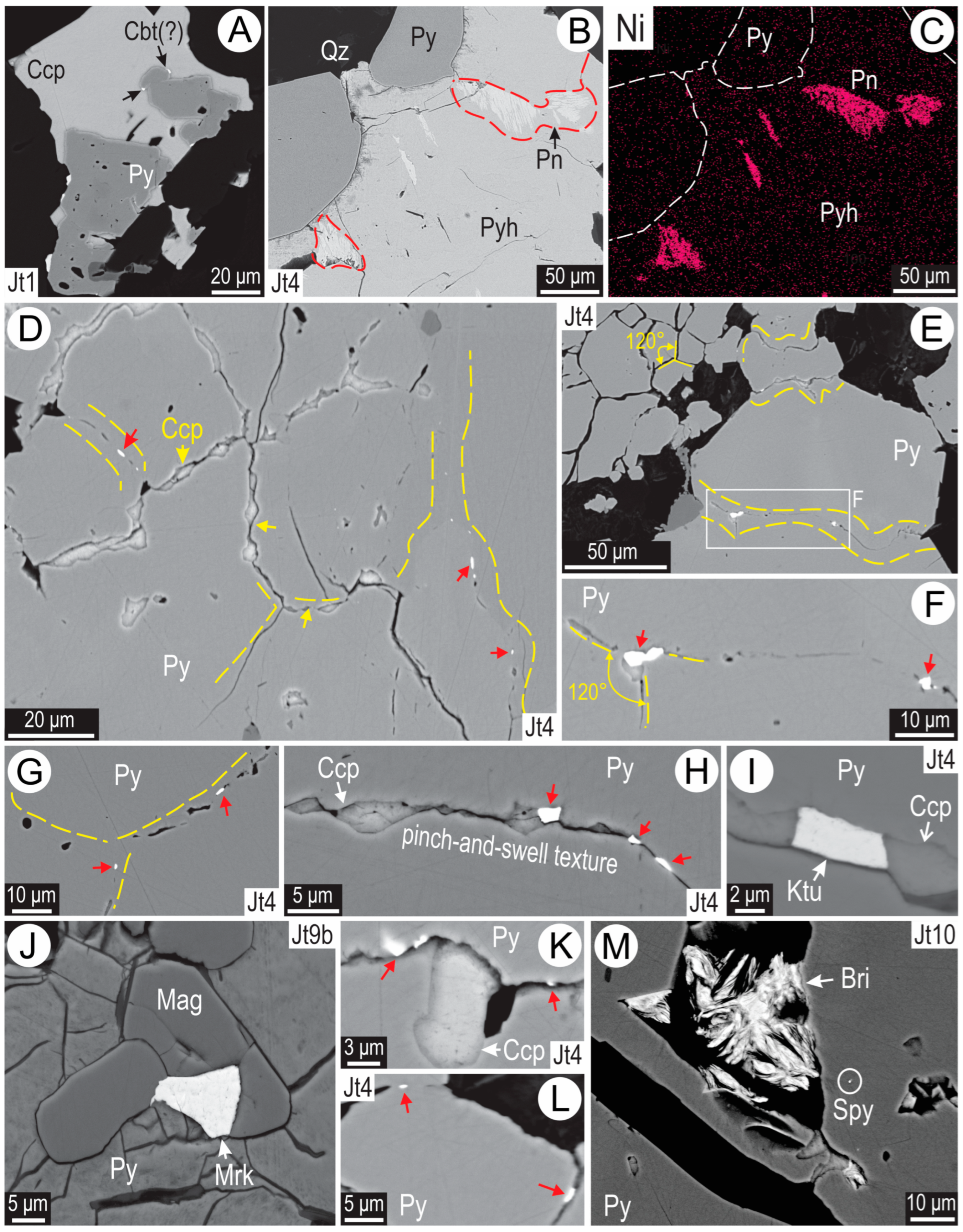

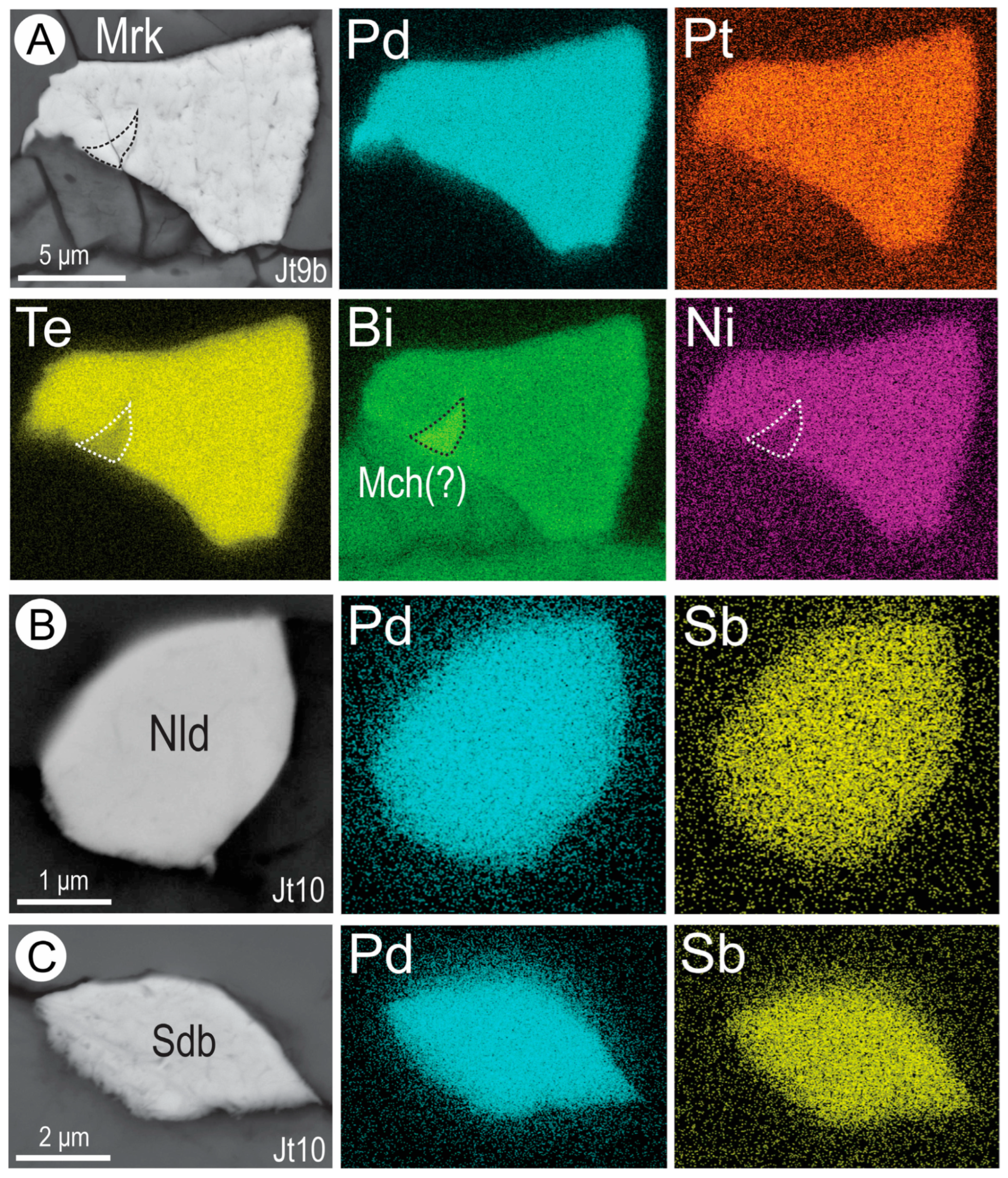
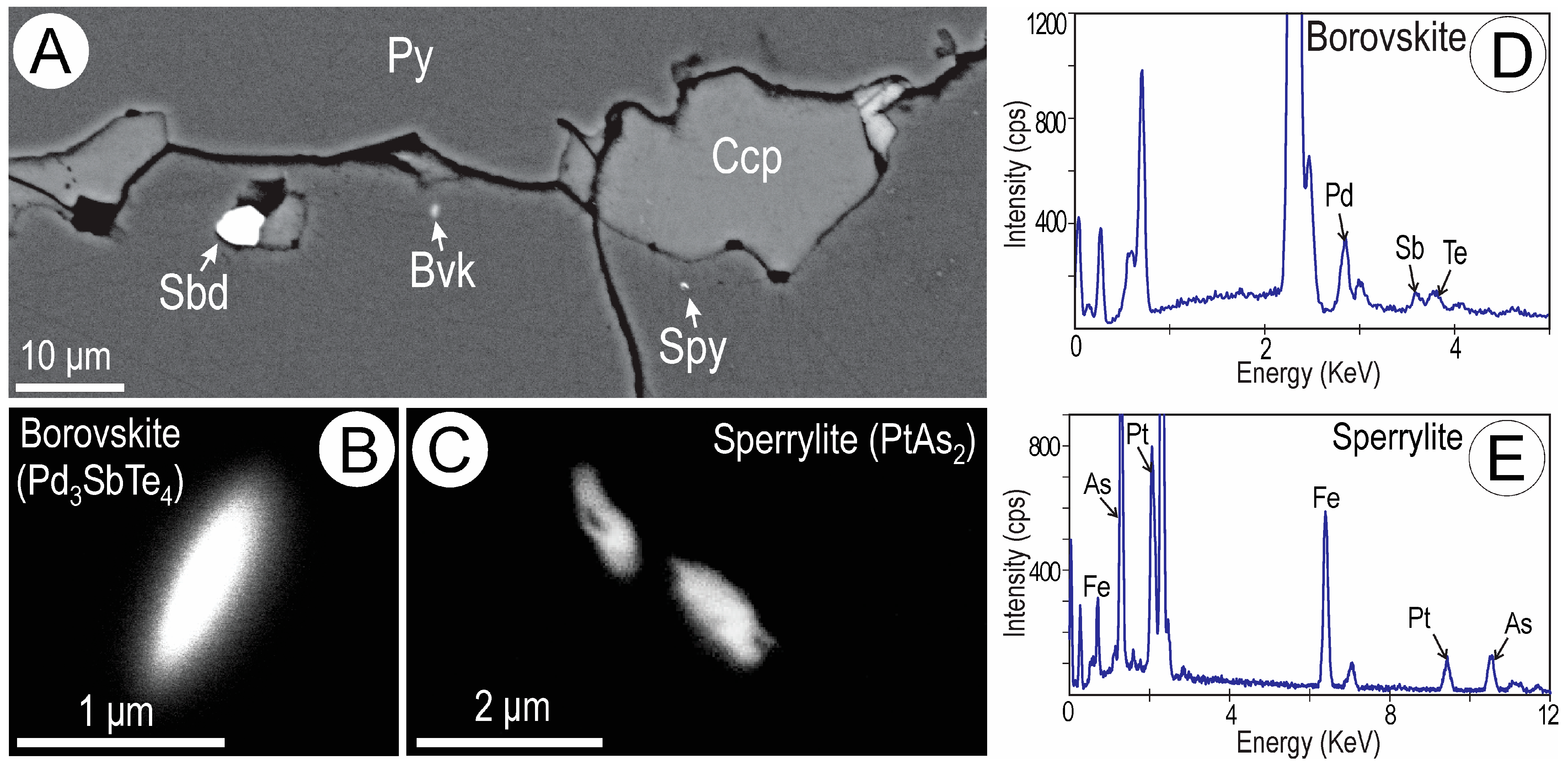

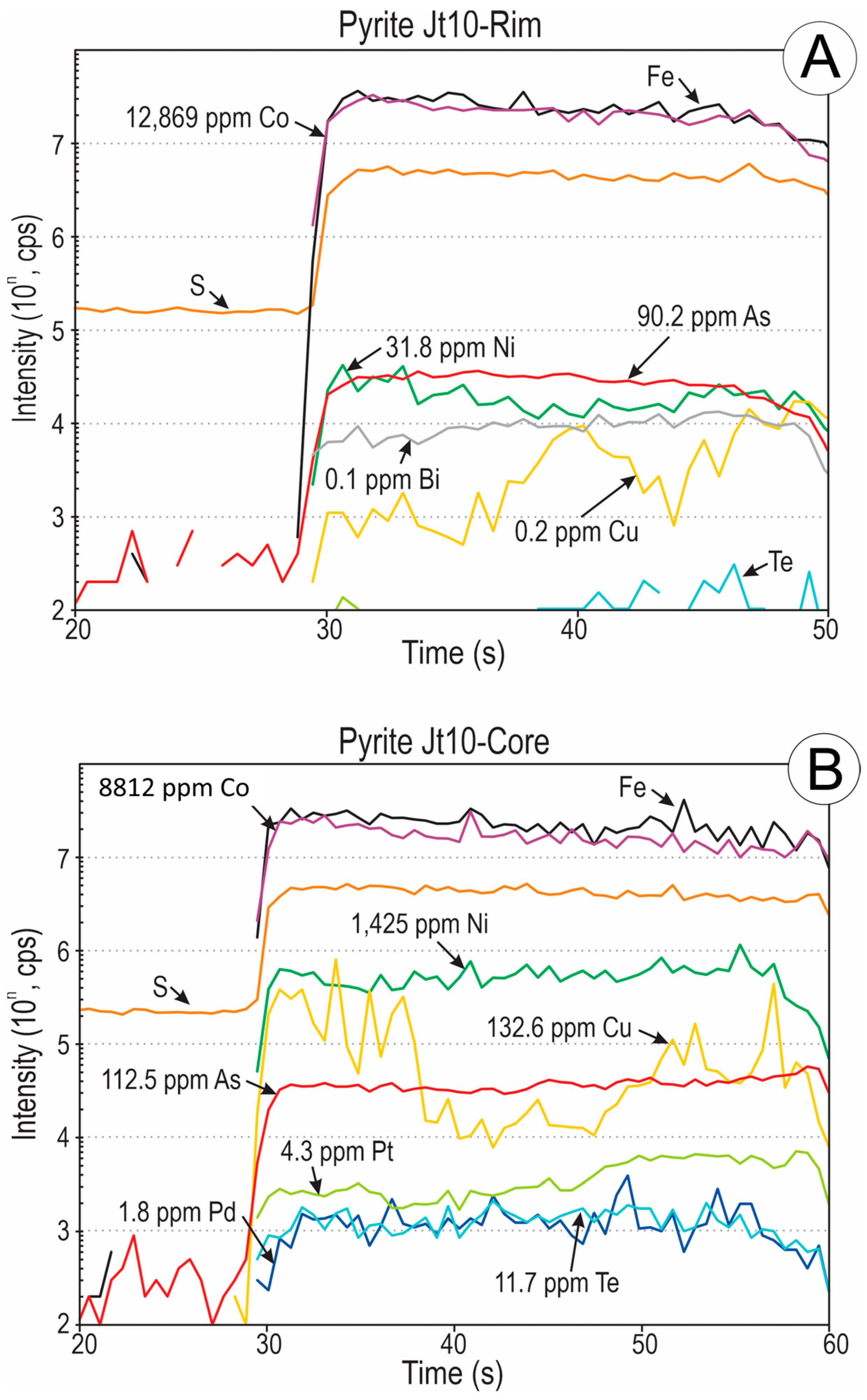
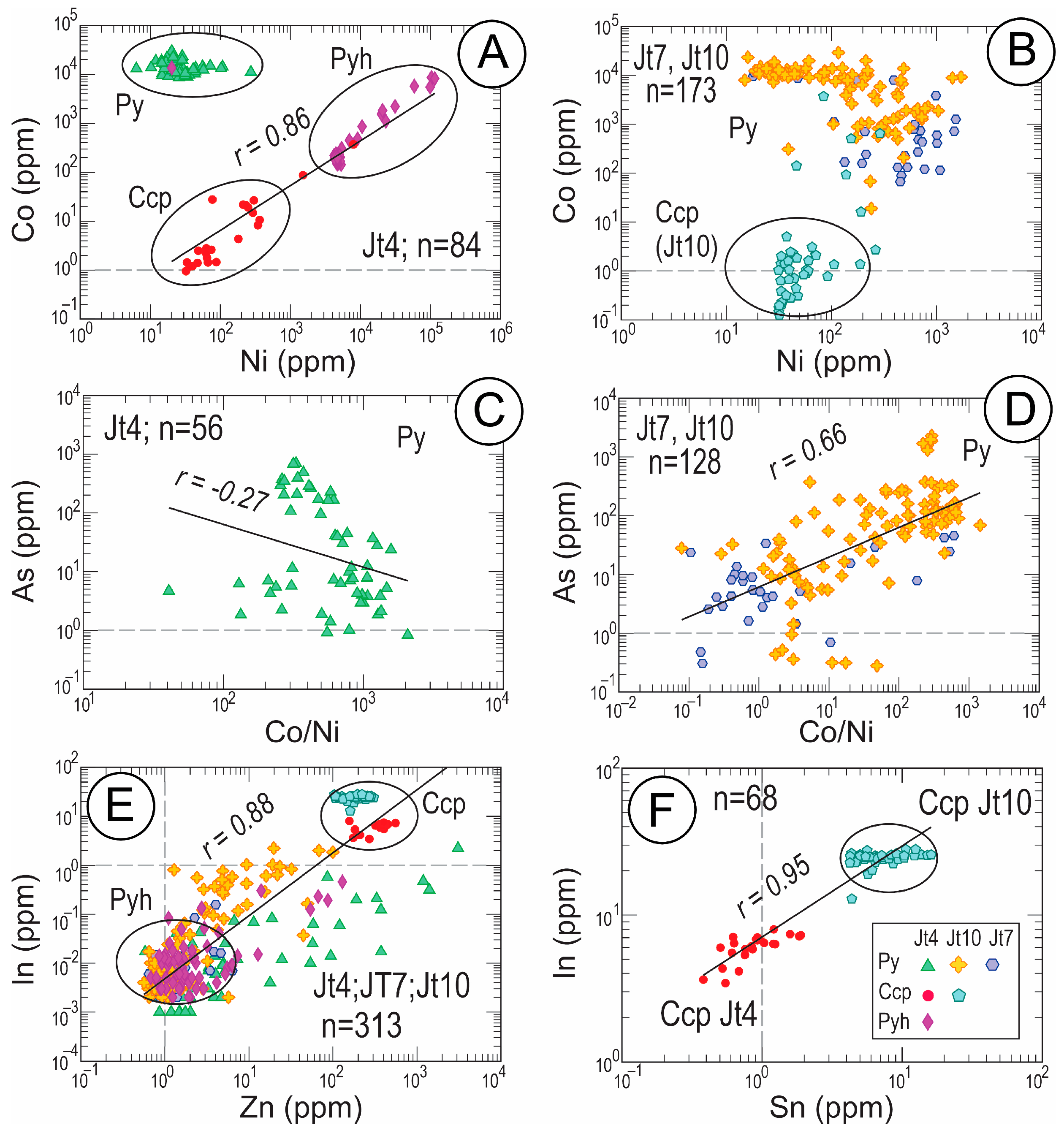

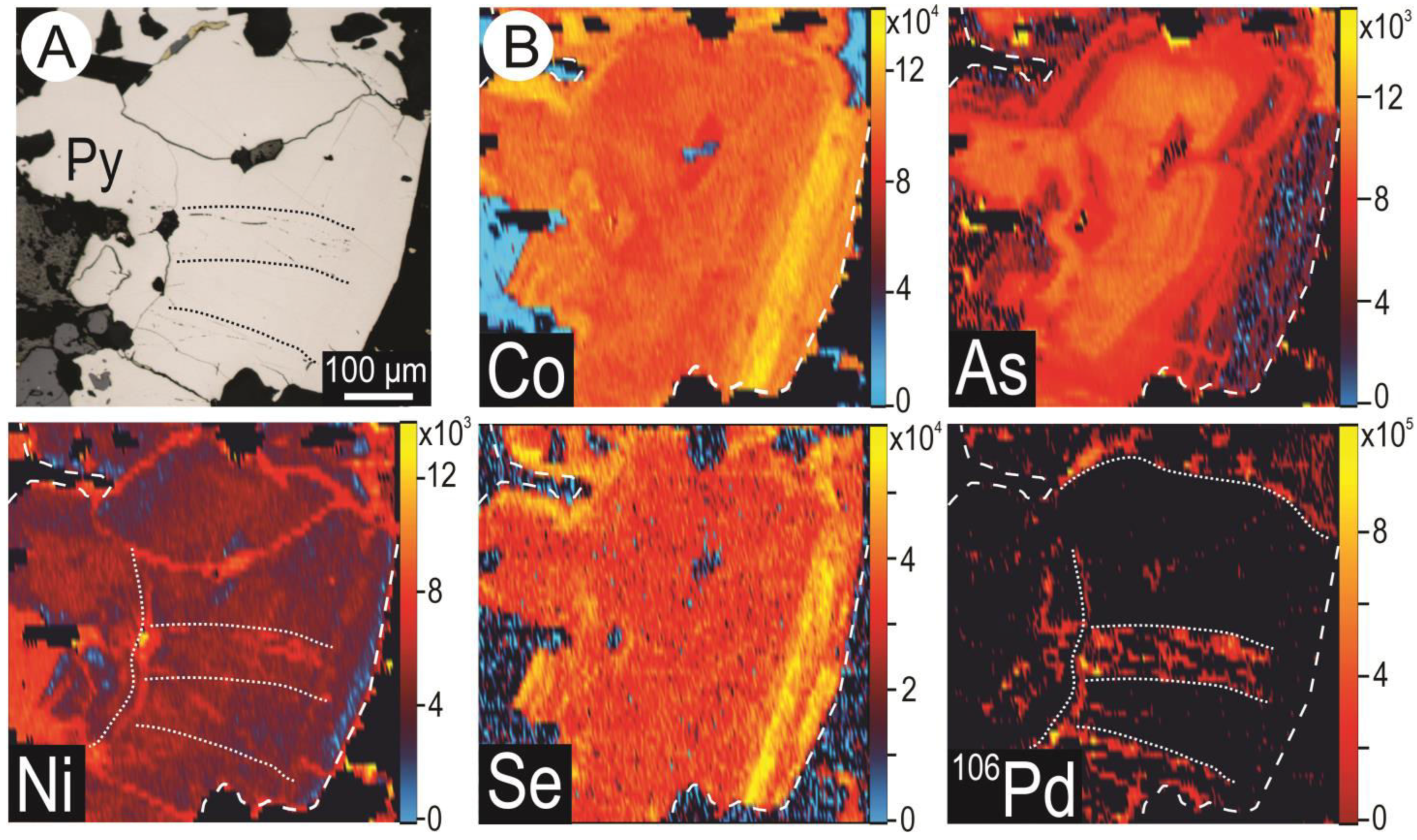


| 1 | 2 | 3 | 4 | 5 | |
|---|---|---|---|---|---|
| Bi-Bearing Merenskyite (Jt4) | Merenskyite (Jt9) | Ni-Bi-Bearing Merenskyite (Jt9) | Merenskyite (Jt8) | Naldrettite (Jt10) | |
| Mean (n = 4, single grain) | Mean (n = 3, single grain) | Mean (n = 4, single grain) | |||
| Pd | 27.8 ± 1.53 | 29.9 ± 0.60 | 22.3 ± 0.29 | 26.9 | 67.0 |
| Bi | 16.4 ± 0.76 | 2.1 ± 0.2 | 15.8 ± 1.11 | ||
| Te | 53.4 ± 2.10 | 67.9 ± 0.40 | 54.5 ± 2.50 | 73.1 | |
| Pt | 3.4 ± 0.10 | ||||
| Ni | 2.4 ± 0.07 | 1.8 ± 0.26 | |||
| Sb | 33.0 | ||||
| Total | 97.6 ± 3.03 | 100.1 ± 0.06 | 97.7 ± 1.67 | 100.0 | 100.0 |
| Pyrite Jt 4 | Co | Ni | Cu | As | Zn | Bi | Te | Au | Ag | Se | Cd | *In | Sb | Sn | ΣPb | 105Pd | 106Pd | *Pd | Pt |
|---|---|---|---|---|---|---|---|---|---|---|---|---|---|---|---|---|---|---|---|
| Mean (n = 56) | 14532 | 33 | 2002 | 99 | 136 | 12 | 31 | 0.060 | 0.054 | 97 | 0.585 | 0.043 | 0.336 | 0.108 | 5.1 | 8.7 | 6.1 | 7.4 | 0.043 |
| S.D. | 4823 | 38 | 8203 | 167 | 473 | 24 | 131 | 0.230 | 0.091 | 40 | 2.9 | 0.155 | 0.570 | 0.378 | 6.9 | 43 | 26 | 35 | 0.228 |
| Median | 13104 | 23 | 6.0 | 8.8 | 3.6 | 3.9 | 2.3 | 0.008 | 0.023 | 97 | 0.010 | 0.004 | 0.102 | 0.034 | 1.9 | 0.033 | 0.027 | 0.033 | 0.004 |
| Maximum | 29711 | 273 | 57218 | 697 | 3080 | 144 | 923 | 1.7 | 0.497 | 187 | 21.1 | 1.1 | 2.8 | 2.8 | 32 | 311 | 181 | 246 | 1.7 |
| Minimum | 8666 | 6.3 | 0.225 | 0.828 | 0.582 | <0.002 | <0.042 | 0.001 | <0.001 | 40 | 0.002 | 0.001 | 0.004 | 0.02 | 0.008 | 0.001 | 0.001 | 0.000 | <0.001 |
| Pyrite Jt 7 | |||||||||||||||||||
| Mean (n = 29) | 2441 | 546 | 78 | 11 | 1.7 | 0.613 | 1.2 | 0.002 | 0.082 | 116 | 0.009 | 0.007 | 0.397 | 0.041 | 3.0 | 0.046 | 0.041 | 0.044 | 0.294 |
| S.D. | 3799 | 419 | 90 | 13 | 1.4 | 0.972 | 2.1 | 0.003 | 0.188 | 40 | 0.013 | 0.016 | 0.476 | 0.023 | 3.9 | 0.077 | 0.064 | 0.070 | 0.329 |
| Median | 599 | 500 | 292 | 5.4 | 1.1 | 0.195 | 0.395 | 0.001 | 0.021 | 116 | 0.006 | 0.003 | 0.149 | 0.035 | 1.3 | 0.016 | 0.015 | 0.018 | 0.161 |
| Maximum | 11669 | 1533 | 0.9 | 45 | 6.4 | 4.6 | 11 | 0.013 | 0.937 | 211 | 0.073 | 0.078 | 1.6 | 0.144 | 12 | 0.362 | 0.266 | 0.314 | 1.3 |
| Minimum | 67 | 18 | 1450 | <0.305 | 0.645 | 0.004 | <0.054 | 0.001 | <0.001 | 55 | 0.002 | 0.001 | 0.012 | 0.026 | 0.010 | 0.001 | 0.001 | 0.000 | 0.004 |
| Pyrite Jt 10 | |||||||||||||||||||
| Mean (n = 99) | 8012 | 229 | 1371 | 181 | 6.0 | 3.5 | 1.8 | 0.051 | 0.351 | 116 | 0.021 | 0.092 | 0.575 | 0.381 | 6.6 | 0.247 | 0.223 | 0.235 | 1.7 |
| S.D. | 5766 | 291 | 3413 | 400 | 14 | 4.7 | 2.9 | 0.266 | 0.620 | 40 | 0.041 | 0.205 | 0.662 | 1.5 | 10 | 0.358 | 0.348 | 0.350 | 2.8 |
| Median | 8912 | 128 | 7.9 | 71 | 1.3 | 1.6 | 0.580 | 0.006 | 0.101 | 119 | 0.008 | 0.005 | 0.285 | 0.054 | 2.8 | 0.081 | 0.077 | 0.076 | 0.489 |
| Maximum | 28916 | 1721 | 19113 | 2302 | 100 | 23 | 22 | 2.6 | 3.3 | 238 | 0.272 | 1.1 | 2.8 | 15 | 51 | 1.8 | 1.8 | 1.8 | 15 |
| Minimum | 19 | 15 | 0.156 | <0.278 | 0.563 | <0.002 | <0.043 | 0.001 | <0.001 | 30 | 0.001 | 0.001 | 0.010 | 0.031 | 0.010 | 0.001 | 0.001 | 0.001 | <0.001 |
| Pyrrhotite Jt4 | Co | Ni | Cu | As | Zn | Bi | Te | Au | Ag | Se | Cd | *In | Sb | Sn | ΣPb | 105Pd | 106Pd | *Pd | |
| Mean (n = 61) | 981 | 12023 | 961 | 0.620 | 7.9 | 0.315 | 0.177 | 0.004 | 0.254 | 106 | 0.033 | 0.017 | 0.033 | 0.067 | 6.4 | 0.059 | 0.045 | 0.052 | |
| S.D. | 2403 | 23152 | 5996 | 0.885 | 22 | 0.333 | 0.098 | 0.006 | 0.634 | 6.2 | 0.069 | 0.039 | 0.043 | 0.056 | 11 | 0.238 | 0.166 | 0.200 | |
| Median | 201 | 4899 | 2.1 | 0.426 | 1.7 | 0.232 | 0.151 | 0.001 | 0.043 | 106 | 0.016 | 0.005 | 0.021 | 0.054 | 3.2 | 0.001 | 0.001 | 0.001 | |
| Maximum | 13582 | 115245 | 45434 | 5.4 | 129 | 1.6 | 0.571 | 0.032 | 3.2 | 131 | 0.520 | 0.228 | 0.288 | 0.415 | 68 | 1.5 | 0.968 | 1.1 | |
| Minimum | 143 | 20 | 0.433 | 0.328 | 0.680 | <0.001 | <0.065 | 0.001 | <0.001 | 95 | 0.005 | 0.001 | <0.005 | 0.022 | 0.037 | 0.001 | 0.001 | 0.000 | |
| Chalcopyrite Jt 4 | Co | Ni | Cu | As | Zn | Bi | Te | Au | Ag | Se | Cd | *In | Sb | Sn | ΣPb | Pt | |||
| Mean (n = 23) | 28 | 538 | 0.447 | 348 | 0.861 | 0.365 | 0.011 | 0.380 | 100 | 0.826 | 3.0 | 0.061 | 0.932 | 11 | 0.005 | ||||
| S.D. | 77 | 1643 | 0.251 | 102 | 2.8 | 0.231 | 0.010 | 0.183 | 7.2 | 0.175 | 0.609 | 0.052 | 0.408 | 10 | 0.008 | ||||
| Median | 2.8 | 77 | 0.368 | 390 | 0.240 | 0.326 | 0.006 | 0.361 | 99 | 0.840 | 3.2 | 0.035 | 0.856 | 6.9 | 0.002 | ||||
| Maximum | 372 | 7943 | 1.3 | 557 | 14 | 0.950 | 0.035 | 1.1 | 113 | 1.2 | 4.0 | 0.233 | 1.9 | 40 | 0.031 | ||||
| Minimum | 0.956 | 32 | <0.262 | 157 | 0.087 | 0.108 | <0.001 | 0.237 | 86 | 0.504 | 1.7 | 0.018 | 0.381 | 1.6 | <0.001 | ||||
| Chalcopyrite Jt 10 | |||||||||||||||||||
| Mean (n = 45) | 114 | 68 | 1.2 | 206 | 0.755 | 0.330 | 0.044 | 17 | 121 | 0.337 | 12 | 0.084 | 7.3 | 15 | 0.015 | ||||
| S.D. | 558 | 60 | 2.6 | 52 | 1.4 | 0.496 | 0.063 | 2.6 | 17 | 0.135 | 1.3 | 0.091 | 2.9 | 11 | 0.026 | ||||
| Median | 1.1 | 43 | 0.325 | 218 | 0.316 | 0.162 | 0.013 | 16 | 123 | 0.320 | 12 | 0.045 | 6.4 | 13 | 0.003 | ||||
| Maximum | 3686 | 291 | 14 | 306 | 7.6 | 2.5 | 0.258 | 26 | 151 | 0.788 | 15 | 0.383 | 16 | 48 | 0.125 | ||||
| Minimum | 0.081 | 32 | <0.219 | 104 | 0.090 | <0.046 | 0.001 | 10 | 86 | 0.047 | 6.4 | <0.011 | 4.2 | 1.6 | <0.001 | ||||
Disclaimer/Publisher’s Note: The statements, opinions and data contained in all publications are solely those of the individual author(s) and contributor(s) and not of MDPI and/or the editor(s). MDPI and/or the editor(s) disclaim responsibility for any injury to people or property resulting from any ideas, methods, instructions or products referred to in the content. |
© 2024 by the authors. Licensee MDPI, Basel, Switzerland. This article is an open access article distributed under the terms and conditions of the Creative Commons Attribution (CC BY) license (https://creativecommons.org/licenses/by/4.0/).
Share and Cite
Campo Rodriguez, Y.T.; Cook, N.J.; Ciobanu, C.L.; Schutesky, M.E.; King, S.A.; Gilbert, S.; Ehrig, K. Platinum Group Minerals Associated with Nickel-Bearing Sulfides from the Jatobá Iron Oxide-Copper-Gold Deposit, Carajás Domain, Brazil. Minerals 2024, 14, 757. https://doi.org/10.3390/min14080757
Campo Rodriguez YT, Cook NJ, Ciobanu CL, Schutesky ME, King SA, Gilbert S, Ehrig K. Platinum Group Minerals Associated with Nickel-Bearing Sulfides from the Jatobá Iron Oxide-Copper-Gold Deposit, Carajás Domain, Brazil. Minerals. 2024; 14(8):757. https://doi.org/10.3390/min14080757
Chicago/Turabian StyleCampo Rodriguez, Yuri Tatiana, Nigel J. Cook, Cristiana L. Ciobanu, Maria Emilia Schutesky, Samuel A. King, Sarah Gilbert, and Kathy Ehrig. 2024. "Platinum Group Minerals Associated with Nickel-Bearing Sulfides from the Jatobá Iron Oxide-Copper-Gold Deposit, Carajás Domain, Brazil" Minerals 14, no. 8: 757. https://doi.org/10.3390/min14080757





